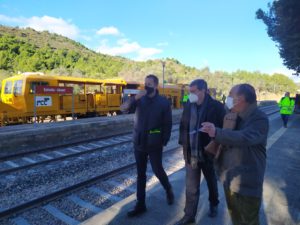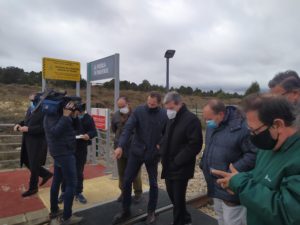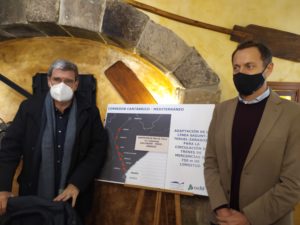
The president of the Port Authority of Valencia (PAV), Aurelio Martínez, stressed “we are very pleased to promote this strategic line for rail freight traffic from Aragon to the Port of Valencia”.
Martínez pointed out that “this action connects the Cantabrian corridor with the Mediterranean, very dynamic centres of Spanish economic activity, which will require a double track within a reasonable period of time”.
The president of the PAV and the general director of ADIF, Àngel Contreras, have visited the 750-metre sidings for trains in Estivella and La Puebla de Valverde.
The seven sidings between Teruel and Valencia will be completed by the end of the first quarter of 2022 and active by the end of that year,” said Àngel Contreras.
The works to improve the Zaragoza-Teruel-Sagunto-Valencia railway line are progressing at a good pace, a strategic infrastructure to link the Cantabrian corridor with the Mediterranean. This was verified this morning by the general director of ADIF, Àngel Contreras, and the president of the PAV, Aurelio Martínez, who visited the sidings at Estivella in the province of Valencia and La Puebla de Valverde in Teruel. “The improvement of this line is strategic for Valenciaport and Spanish economic activity, as it will make it easier to attract freight traffic from the north of Spain to its eastern exit from the Port of València,” said the PAV president. Valenciaport accounts for 41% of the import/export activity of the Spanish port system, it is the leading port in terms of container movement and the best connected in Spain. Hence, with this type of action, the Port of València aspires to “have a greater presence in the northern areas that move traffic to the east”.
“This route linking Valencia with Teruel and Zaragoza is fundamental, which is why Valenciaport has been committed to it from the very first minute, as it connects very dynamic centres of growth in the Spanish economy, which will attract goods traffic from these parts of Spain through the Port of Valencia”, Aurelio Martínez assured. “An infrastructure that in the coming years, if the demand for traffic from Valencia to Zaragoza and the north, and vice versa, continues to increase, will make it necessary to consider the double track”.
The investment in the improvement of the railway network is yielding results as the works progress. A commitment that began with the agreement in 2017 and actions in the following years, as the president of the PAV recalled, with actions that began in 2018, and that, over these years, with the works that have been carried out, “traffic began to grow in an upward line. We are very pleased to promote this line and now we want it to be completed as soon as possible”, added Aurelio Martínez.
This is demonstrated in the works on the Zaragoza-Teruel-València line of the Cantabrian-Mediterranean axis that are progressing at a good pace and, in particular, in the construction of seven 750-metre-long sidings at stations located in Aragon and the Valencian Community. Specifically, these sidings are located in Cariñena, Ferreruela, Teruel, La Puebla de Valverde, Barracas, Navajas and Estivella, the last four of which have practically been completed, to which must be added the one in Cella. The construction of these infrastructures has 20.6 million euros financed by the PAV.
The general director of ADIF has pointed out that “between March and April next year these seven sidings will be finished and we are confident that after the tests carried out they can be in operation by the end of 2022”. Thus, for example, with the commissioning of the overland train on this line, weekly freight traffic has increased significantly. If in 2017 the average number of weekly trains to the Port of Sagunto was five, in 2021 it will be 30 services, with a peak week of 44 weekly freight trains. These figures could reach 50-60 trains per week from Zaragoza once the works are completed.

Tangible results
The Master Plan for the Zaragoza-Teruel-Sagunto line has a global investment of 441 million euros, of which 100 million have already been executed and more than 200 million euros awarded. The aim of the plan is to significantly improve the state of the current infrastructure to further enhance this section, especially for freight traffic, as it will allow the circulation of 750-metre trains, facilitating rail-port connections and connections with logistics centres on this strategic railway axis, which runs through territories that represent 21% of the state’s GDP. “The line is advanced, we are now in the electrification phase. ADIF has not stopped working and the results are there. Railway traffic has increased more than tenfold in recent years”, said Àngel Contreras.
Once all the infrastructures have been completed, the line will have greater capacity, journey times will be reduced, the competitiveness of freight services will improve, traffic speed will increase, efficiency will increase, electric traction trains can be incorporated, better reliability and comfort parameters will be offered, the possibility of incidents will be reduced and the infrastructure will be fully interoperable with the Cantabrian and Mediterranean corridors.
These advances are demonstrated by the main shipping companies that are already including the València-Teruel-Zaragoza route in their routes. In this sense, MSC started up a rail service dedicated exclusively to reefer transport between Valencia and Zaragoza, while CSP Iberian Rail has already set up its new rail service linking the Port of Valencia with Zaragoza, with an initial frequency of three weekly rotations with a composition of 56 TEUs each. In addition, the French shipping company CMA CGM is finalising a new rail service between the Valencian precinct and Zaragoza, a new link, part of the company’s ‘Switch to Rail’ product, which will have three weekly departures and allows significant flexibility for goods.


